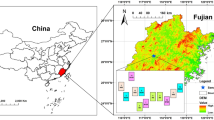Abstract
A microcosm experiment was carried out to quantify the effects of organisms at various trophic levels on C and N mineralization after the addition of crop residues to arable soil. The effects of the bacterivorous nematodes Rhabditis sp. and Acrobeloides bütschlii and of the nematophagous fungi Arthrobotrys oligospora und Drechmeria coniospora on soil respiration and N mineralization were measured over 6 months at 20°C. In the presence of nematodes, C mineralization was increased during the first month and subsequently reduced; N mineralization was increased during the first 2 months and then reduced. The results support the assumption that nematodes influence C mineralization mainly indirectly by affecting bacterial activity, and N mineralization mainly directly by mineralizing bacterial biomass. A. oligospora contributed directly to C mineralization. The effect of both fungi on N mineralization was indirect and resulted from the reduction in the numbers of nematodes. The results showed that the effects of nematodes and nematophagous fungi and the mechanisms behind the effects may vary strongly in time, and are correlated with the type of organic matter decomposed.
Similar content being viewed by others
References
Barron GL (1977) The nematode-destroying fungi. Topics in mycobiology, vol 1, Canadian Biological Publications, Guelph
Bird AF (1987) Adhesion of microorganisms to nematodes. J Nematol 19:514
Brussaard L, Kools JP, Bouwman LA, De Ruiter PC (1991) Population dynamics and nitrogen mineralization rates in soil as influenced by bacterial grazing nematodes and mites. In: Veeresh GK, Rajagopal D, Viraktamath (eds) Advances in management and conservation of soil fauna Oxford and IBH Publishing Co, New Delhi, pp 517–523
Bloem J, De Ruiter PC, Koopman GJ, Lebbink G, Brussaard L (1992) Microbial numbers and activity in dried and rewetted arable soil under integrated and conventional management. Soil Biol Biochem 24:655–665
Chantano A, Jensen HJ (1969) Saprozoic nematodes as carriers and disseminators of plant pathogenic bacteria. J Nematol 1:216–218
Clarholm M (1985) Interactions of bacteria, protozoa and plants leading to mineralization of soil nitrogen. Soil Biol Biochem 17:181–187
Clarholm M, Rosswall T (1980) Biomass and turnover of bacteria in a forest soil and a peat. Soil Biol Biochem 12:49–57
Coleman DC, Anderson RV, Cole CV, Elliot ET, Woods L, Campion MK (1978) Trophic interactions in soils as they affect energy and nutrient dynamics. IV. Flows of metabolic and biomass carbon. Microb Ecol 4:373–380
Cooke RC (1963) Ecological characteristics of nematode-trapping hyphomycetes. I. Preliminary Studies. Ann Apl Biol 52:431
Dürschner U (1983) Pilzliche Endoparasiten an beweglichen Nematoden stadien. Mitt Biol Bundesans Land Forstwirtsch 217:1–83
Freckman DW (1988) Bacterivorous nematodes and organic matter decomposition. Agric Ecosyst Environ 24:195–217
Hassink J, Bouwman LA, Zwart KB, Brussaard L (1993) Relationships between habitable pore space, soil biota and mineralization rates in grassland soils. Soil Biol Biochem 25:47–55
Hunt HW, Coleman DC, Ingham ER, Elliott ET, Moore JC, Rose SL, Reid CPP, Morley CR (1987) The detrital foodweb in a shortgrass prairie. Biol Fertil Soils 3:57–68
s'Jacob JJ, van Bezooyen J (1984) Practical work in nematology. Agric Univ, Wageningen
Jatala P, Jensen HJ, Russell SA (1974) Pristionchus iheritieri as a carrier of Rhizobium japonicum. J Nematol 6:130–131
Kooistra MJ, Lebbink G, Brussaard L (1989) The Dutch programme on soil ecology of arable farming systems. II. Geogenesis, agricultural history, field site characteristics and present farming systems at the Lovinkhoeve experimental farm. Agric Ecosyst Environ 27:361–387
Kuikman PJ, Van Veen JA (1989) The impact of protozoa on the availability of bacterial nitrogen to plants Biol Fertil Soils 8:13–18
Kuikman PJ, Jansen AG, van Veen JA, Zehnder AJB (1990) Protozoan predation and the turnover of soil organic carbon and nitrogen in the presence of plants. Biol Fertil Soils 10:22–28
Lebbink G, Van Faassen HG, Van Ouwerkerk C, Brussaard L (1994) The Dutch programme on soil ecology of arable farming systems: General characteristics of the field, farm management, monitoring programme and general results. Agric Ecosystems Environ (in press)
Meyers RF, Krusberg LR (1965) Organic substances discharged by plant parasitic nematodes. Phytopathology 55:429–437
Moore JC, De Ruiter PC (1991) Temporal heterogeneity of trophic interactions within belowground food webs. Agric Ecosyst Environ 34:371–397
Moore JC, Hunt HW (1988) Resource compartmentation and the stability of real ecosystems. Nature 333:261–263
Nielsen CO (1949) Studies on the soil microfauna. II. The soil inhabiting nematodes. Nat Jutl 2:1–131
Poinar GO, Jansson HB (1988) Diseases of Nematodes, vol II CRC Press, Boca Raton, Florida
Postma J, Van Veen JA (1990) Habitable pore space and survival of Rhizobium leguminosarum biovar trifolii introduced into soil. Microb Ecol 19:149–161
Schiemer F (1987) Nematoda. In: Pandian TJ, Vernberg FJ (eds) Animal energetics, vol 1. Academic Press, New York, pp 185–215
Veen JA van, Paul EA (1979) Conversion of biovolume measurements of soil organisms grown under various moisture tensions, to biomass and their nutrient content. Appl Environ Microbiol 3:686–692
Verhoef HA, Brussaard L (1990) Decomposition and nitrogen mineralization in natural and agro-ecosystems: The contribution of soil animals. Biogeochemistry 11:175–211
Wardle DA, Yeates GW (1993) The dual importance of competition and predation as regulatory forces in terrestrial ecosystems: Evidence from decomposer food-webs: Oecologia 93:303–306
Wright DJ, Newall DR (1976) Nitrogen excretion osmotic and ionic regulation in nematodes. In: Croll NA (ed) The organization of nematodes. Academic Press, London, pp 163–210
Author information
Authors and Affiliations
Additional information
Work was carried out at the DLO Research Institute for Agrobiology and Soil Fertility, Haren
Rights and permissions
About this article
Cite this article
Bouwman, L.A., Bloem, J., van den Boogert, P.H.J.F. et al. Short-term and long-term effects of bacterivorous nematodes and nematophagous fungi on carbon and nitrogen mineralization in microcosms. Biol Fert Soils 17, 249–256 (1994). https://doi.org/10.1007/BF00383977
Received:
Issue Date:
DOI: https://doi.org/10.1007/BF00383977




